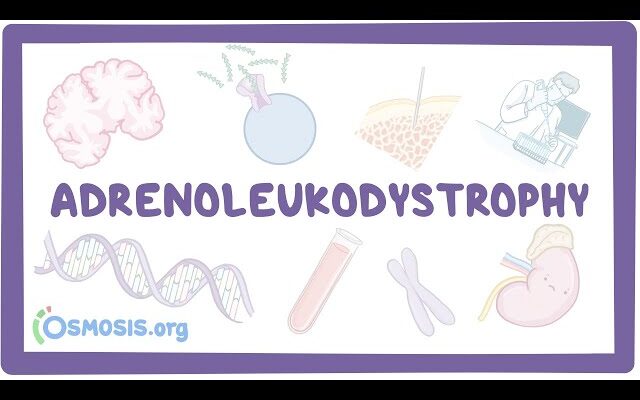Adrenoleukodystrophy Symptoms: Adrenoleukodystrophy (ALD) is a rare genetic condition that affects the nervous system and adrenal glands.
It is characterized by the progressive degeneration of the myelin sheath, a fatty layer that insulates nerve cells in the brain and spinal cord.
This article aims to provide a comprehensive overview of the symptoms and causes of ALD, alongside the latest insights into its diagnosis and management.
Understanding Adrenoleukodystrophy
Adrenoleukodystrophy is caused by mutations in the ABCD1 gene, which is responsible for the production of the ALD protein. This protein plays a crucial role in the breakdown and transport of very long-chain fatty acids (VLCFAs). When the ALD protein is defective, VLCFAs accumulate in the body, particularly in the central nervous system, leading to the destruction of the myelin sheath.
Clinical Manifestations of Adrenoleukodystrophy
The condition presents in various forms, which can be broadly categorized based on the age of onset and severity of symptoms. The most severe form, childhood cerebral ALD, typically emerges between the ages of 4 and 10 and progresses rapidly. Adolescents and adults may experience a milder form, known as adrenomyeloneuropathy (AMN), which progresses more slowly.
Symptoms of Adrenoleukodystrophy can vary but often include:
- Neurological Impairments: such as seizures, hyperactivity, and learning disabilities in children.
- Behavioral Changes: aggression, isolation, and withdrawal may be early indicators.
- Physical Disabilities: loss of coordination, weakness, and difficulty swallowing or speaking as the disease progresses.
- Adrenal Insufficiency: fatigue, weight loss, skin pigmentation changes, and vomiting.
The Genetic Basis of ALD
Adrenoleukodystrophy is an X-linked genetic condition, meaning the mutated gene is located on the X chromosome. This has significant implications for inheritance patterns:
- Males (with one X chromosome) who inherit the defective gene will develop the disease.
- Females (with two X chromosomes) may become carriers without showing symptoms, or they may exhibit milder symptoms due to one normal ALD gene.
Diagnostic Approaches to ALD
Diagnosing ALD involves a combination of clinical assessment, genetic testing, and biochemical assays:
- Blood Tests: Elevated levels of VLCFAs in the blood are a hallmark of ALD.
- Genetic Testing: Can confirm the presence of mutations in the ABCD1 gene.
- Imaging Techniques: MRI scans of the brain can reveal white matter abnormalities indicative of myelin loss.
Current Therapies for ALD
While there is no cure for ALD, certain treatments can help manage symptoms and slow progression:
- Stem Cell Transplant: Effective in halting the progression of cerebral ALD if performed early.
- Adrenal Hormone Replacement: For those with adrenal insufficiency, this treatment is crucial.
- Dietary Management: Involving the reduction of VLCFA intake and supplementation with Lorenzo’s oil may help to slow disease progression.
Research and Future Directions
Ongoing research into ALD is focused on gene therapy, with the aim of correcting the underlying genetic defect. Clinical trials are currently investigating the efficacy and safety of such treatments, offering hope for a more definitive future therapy.
Living with ALD
Supporting an individual with ALD involves a multidisciplinary approach:
- Neurological Support: Regular monitoring and therapies for neurological decline.
- Physical Therapy: To maintain mobility and function.
- Psychological Support: Counseling for the individual and family.
Advocacy and Support Networks
Families affected by ALD can find support and advocacy through organizations dedicated to rare diseases. These groups provide resources, raise awareness, and support research efforts.
FAQs about Adrenoleukodystrophy Symptoms
What are the first signs of Adrenoleukodystrophy?
The initial symptoms of ALD can be subtle and vary depending on the type of ALD. In childhood-onset ALD, early signs may include difficulty with comprehension and behavior, as well as changes in handwriting and academic performance. Adults with ALD might experience muscle weakness, vision problems, or changes in behavior.
Can Adrenoleukodystrophy symptoms be different in adults and children?
Yes, the presentation of ALD symptoms can differ significantly. Children, especially boys with the childhood cerebral form, may show symptoms related to brain function like attention deficit and hyperactivity, whereas adults often develop symptoms that affect physical abilities, such as coordination and muscle control.
How does Adrenoleukodystrophy progress?
ALD progresses at varying rates, but without treatment, it typically leads to increasing neurological disability. Early diagnosis and interventions like stem cell transplants can sometimes slow or halt disease progression in children with cerebral ALD.
What causes Adrenoleukodystrophy?
ALD is caused by a genetic mutation in the ABCD1 gene, which affects the body’s ability to break down very-long-chain fatty acids (VLCFAs), leading to their harmful buildup in the brain, adrenal gland, and nervous system.
Is there a genetic predisposition to ALD symptoms?
Yes, ALD is an X-linked genetic condition, meaning the mutation is found on the X chromosome. Males, having only one X chromosome, are more likely to exhibit severe symptoms, while females, with two X chromosomes, may be carriers and can exhibit milder symptoms or sometimes none at all.
For further details on ALD symptoms and progression, it’s crucial to consult healthcare professionals who can provide personalized and updated information.
Conclusion
Lastly, the power of awareness and education cannot be overstated. Spreading knowledge about ALD creates a ripple effect – fostering a supportive community, driving research funding, and ensuring that affected individuals receive the proper care they need.
Let’s all be advocates for this cause: share the knowledge, support the warriors battling ALD, and contribute to the global voice calling for increased research and understanding. Together, we can change the narrative for ALD, turning awareness into action and hope into h



